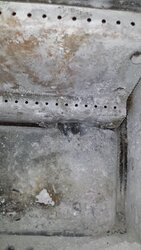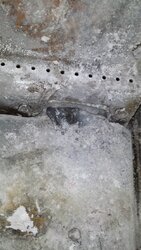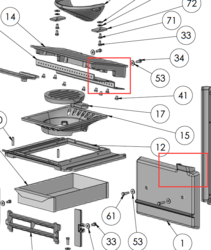We were away from the house for a few days, so I figured it was a good time to clean my stove before I fire it back up. It has seemed just a tad sluggish this year.
This is the beginning of the third season with this stove, and it's my first one. At the end of the previous seasons I had always vacuumed it out really good, but I had never actually removed the baffle. Today, I was able to remove the flat iron plate in front of the baffle with no problem, but when I tried to remove the baffle itself, it only lifted up in front maybe a centimeter but wouldn't move forward or out. So I cleaned all around with a vacuum really well and noticed that one part of soot at the back top of the firebox wouldn't come loose. Then I realized that it looks like there is some sort of melted "something" that seems to have "fastened" the back of the baffle to the rear fire brick! See pics.
So I reached in above the baffle to see what I could feel. Definitely some ash buildup at the very back but didn't seem serious. But amongst the ash, I found two steel (I think steel) washers just sitting loose at the back of the baffle. No idea where they could have come from. I pulled those out, vacuumed again, but still couldn't feel anything odd above the baffle. Nevertheless, here I am with that weird melty spot and a baffle that won't come forward, as well as two mystery washers.
Obviously it's time for a professional inspection. But I'm just curious if anyone has any insight as to what happened here? I've never (to my knowledge) overfired the stove, I've never seen any part of it or the connector/pipe glow, and I have a thermometer and always turn down the air if it looks like it's getting too hot. What did I do wrong?? And where the heck did those washers come from???


This is the beginning of the third season with this stove, and it's my first one. At the end of the previous seasons I had always vacuumed it out really good, but I had never actually removed the baffle. Today, I was able to remove the flat iron plate in front of the baffle with no problem, but when I tried to remove the baffle itself, it only lifted up in front maybe a centimeter but wouldn't move forward or out. So I cleaned all around with a vacuum really well and noticed that one part of soot at the back top of the firebox wouldn't come loose. Then I realized that it looks like there is some sort of melted "something" that seems to have "fastened" the back of the baffle to the rear fire brick! See pics.
So I reached in above the baffle to see what I could feel. Definitely some ash buildup at the very back but didn't seem serious. But amongst the ash, I found two steel (I think steel) washers just sitting loose at the back of the baffle. No idea where they could have come from. I pulled those out, vacuumed again, but still couldn't feel anything odd above the baffle. Nevertheless, here I am with that weird melty spot and a baffle that won't come forward, as well as two mystery washers.
Obviously it's time for a professional inspection. But I'm just curious if anyone has any insight as to what happened here? I've never (to my knowledge) overfired the stove, I've never seen any part of it or the connector/pipe glow, and I have a thermometer and always turn down the air if it looks like it's getting too hot. What did I do wrong?? And where the heck did those washers come from???





